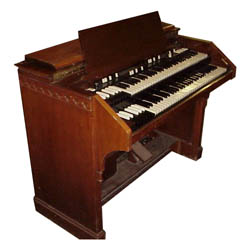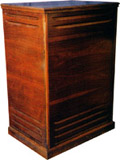|
Nostalgia demo 1
Nostalgia demo 2


|
 |
Like the Fender Rhodes, the
Clavinet and to a lesser degree perhaps, the Wurlitzer EP200 and
the Mellotron, the Hammond organ is undoubtedly one of the best
known keyboard sounds in modern music.
Invented in the mid to late '30s, Laurens Hammond's electric organ
is a huge electro-mechanical beast. Comprising no less than 91 constantly
spinning 'tone wheels' inside it that make up the Hammond's 'tone
generator', each wheel has tiny ridges on their rim which disturb
an electro-magnetic field in a nearby magnet. These disturbances
create tiny, fluctuating voltages which when amplified, generate
something closely resembling sine waves.
The dfferent wheels are used to generate the fundamental frequency
and the various harmonics and sub-harmonics used to create the sound.
A series of drawbars (effectively faders much like you'd find on
a modern mixer) above the upper keyboard allow you to balance the
relative levels of the fundamental and the various harmonics to
create a potentially huge range of sounds. |
| In effect, it was possibly the world's
first real-time additive synthesiser!
The drawbars are the key to the sound as they determine the tone
of the sound. The nine drawbars represent the different length pipes
of a traditional pipe organ. The fundamental drawbar is 'eight foot'
(the length of a pipe required to produce middle C) - the other
drawbars offer 16-, 4-, 2- and 1-foot drawbars producing one octave
below and and consecutive octaves above the fundamental. In addition,
there were 5 1/3, 2 2/3, 1 3/5 and 1 1/3 foot drawbars which introduce
extra tonal richness and the combination of these harmonics along
with percussion effects and chorus and vibrato effects define the
sound being played. The sheer number of drawbar combinations and
other parameters that are available means that the Hammond was capable
of a massive range of tones (although, in fairness, they will all
essentially sound like 'an organ').
Many eminent Hammond players defined their 'sound' with their unique
combination of drawbar settings but there were also presets which
could be recalled using the 'inverted' keys in the bottom octaves
of the two keyboards which, although they look like some strange
extention of the keyboard range were actually nothing more than
switches to select the presets.
But not only was the Hammond a mechanical beast - physically it
was a monster too weighing over 400 pounds! At least four people
are required to carry one so you were in trouble if you had to negotiate
a flight of stairs at your gig! |
| But the mechanics and operation of
the Hammond were only part of the sonic equation.
The Hammond was usually (if not always) amplified through a rotary
speaker that literally throws the sound around a room. As the sound
'moves', so it is subject to the Doppler shift - you know the effect
... where the pitch of an ambulance siren changes as it moves towards
you, passes by and then moves away from you - and this adds a rich
chorus effect to the sound (as well as the distortion created by
the valve amplification). The most famous of these speakers was
the Leslie speaker and that name is now synonymous with the Hammond.
The speakers themselves don't rotate - instead, baffles in which
the speakers are housed spin round powered by a motor and it is
these baffles that throw the sound around. |
 |
| However, the Leslie rotary speaker had
two speeds - slow and fast - and both of these produced distinctively
different sounds. Furthermore, due to the physical ballistics of the
rotary mechanism, you couldn't just switch abruptly between these
two speeds - the rotating speakers sped up or slowed down gradually
as you switched between the two speeds giving rise to yet another
weapon in the mighty Hammond sound. |
| The '3-series' went into production
in 1955 and there were several models in the range. Complete with
bench and bass pedal keyboard, the B3 found favour in jazz circles.
The model C3 console was similarly equipped but used a different
cabinet style. Although it was offered as the "Church Model",
the C3 was the Hammond of choice for many rock players. There was
also the lesser known "Concert Model" - the RT3 which
had a wider C3 cabinet style and built-in amplification.
The 3-series became popular in a wide range of musical environments
from home use to gospel. It was also a mainstay of many jazz and
rock musicians over several decades from Booker T to Keith Emerson
and many, many others - it's a classic sound that defined many different
musical genres. The 3-series ceased production in 1974 as its bulk
and cost was prohibitive for most especially with the arrival of
smaller, lighter electronic organs which although they lacked the
powerful sound of a Hammond tonewheel monster in full flight, were
cheaper and more convenient.
The sound of the original B3 is also
now available new in the form of the authentically modelled B3 from
Hammond themselves! Sonically and cosmetically, it is supposed to
identical to the original. You can find out more at:
http://users.belgacombusiness.net/hammond/new-b3.htm
|
|

